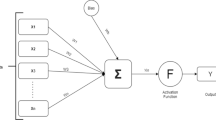Abstract
The aim of this research is to analyse the effectiveness of the Chicago Board Options Exchange Market Volatility Index (VIX) when used with Support Vector Machines (SVMs) in order to forecast the weekly change in the S&P 500 index. The data provided cover the period between 3 January 2000 and 30 December 2011. A trading simulation is implemented so that statistical efficiency is complemented by measures of economic performance. The inputs retained are traditional technical trading rules commonly used in the analysis of equity markets such as Relative Strength Index, Moving Average Convergence Divergence, VIX and the daily return of the S&P 500. The SVM identifies the best situations in which to buy or sell in the market. The two outputs of the SVM are the movement of the market and the degree of set membership. The obtained results show that SVM using VIX produce better results than the Buy and Hold strategy or SVM without VIX. The influence of VIX in the trading system is particularly significant when bearish periods appear. Moreover, the SVM allows the reduction in the Maximum Drawdown and the annualised standard deviation.








Similar content being viewed by others
Notes
The software used is MATLAB 7.8.0 (R2009a).
References
Allen HL, Taylor MP (1990) Charts, noise and fundamentals in the London foreign exchange market. Econ J 100:49–59
Andersen TG, Bollerslev T (1998) Answering the skeptics: yes standard volatility models do provide accurate forecasts. Int Econ Rev 39:885–905
Blair BJ, Poon SH, Taylor SJ (2001) Forecasting S&P 100 volatility: the incremental information content of implied volatilities and high-frequency index returns. J Econom 105:5–26
Bollerslev T (1986) Generalized autoregressive conditional heteroskedasticity. J Econom 31:307–327
Brock W, Lakonishok J, LeBaron B (1992) Simple technical trading rules and the stochastic properties of stock returns. J Finance 47:1731–1764
Burges C (1998) A tutorial on support vector machines for pattern recognition. Data Min Knowl Disc 2:121–167
Canu S, Grandvalet Y, Guigue V, Rakotomamonjy A (2005) SVM and Kernel methods Matlab toolbox, perception systèmes et information. INSA de Rouen, Rouen
Cao L, Tay F (2003) Support vector machine with adaptive parameters in financial time series forecasting. IEEE Trans Neural Networks 14:1506–1518
Chapelle O, Haner P, Vapnik VN (1999) Support vector machines for histogram-based image classification. IEEE Trans Neural Networks 10(5):1055–1064
Chong TT-L, Ng W-K (2008) Technical analysis and the London stock exchange: testing the MACD and RSI rules using the FT30. Appl Econ Lett 15:1111–1114
Cristianini N, Taylor JS (2000) An introduction to support vector machines and other kernel-based learning methods. Cambridge University Press, New York
Dunis CL, Rosillo R, De la Fuente D, Pino R (2013) Forecasting IBEX-35 moves using support vector machines. Neural Comput Appl 23(1):229–236. doi:10.1007/s00521-012-0821-9
Dunis C, Likothanassis S, Karathanasopoulos A, Sermpinis G, Theofilatos K (2013b) A hybrid genetic algorithm-support vector machine approach in the task of forecasting and trading the ASE 20. J Asset Manag 1–20. doi:10.1057/jam.2013.2
Evgeniou T, Pontil M, Poggio T (2000) Regularization networks and support vector machines. Adv Comput Math 13:1–50
Hajizadeh E, Seifi A, Zarandi MNF, Turksen IB (2012) A hybrid modeling approach for forecasting the volatility of S&P 500 index return. Expert Syst Appl 39(1):431–436. doi:10.1016/j.eswa.2011.07.033
Huang S, Sun Z (2001) Support vector machine approach for protein subcellular localization prediction. Bioinformatics 17:721–728
Huang W, Nakamori Y, Wang SY (2005) Forecasting stock market movement direction with support vector machine. Comput Oper Res 32:2513–2522
Kim K (2003) Financial time series forecasting using support vector machines. Neurocomputing 55:307–319
Kwon KY, Kish RJ (2002) Technical trading strategies and return predictability: NYSE. Appl Financ Econ 12:639–653
Lee M-C (2009) Using support vector machine with a hybrid feature selection method to the stock trend prediction. Expert Syst Appl 36(8):10896–10904
Menkhoff L, Taylor MP (2007) The obstinate passion of foreign exchange professionals: technical analysis. J Econ Lit 45:936–972
Mills TC (1997) Technical analysis and the London stock exchange: testing trading rules using the FT30. Int J Finance Econ 2:319–331
Murphy JJ (1999) Technical analysis of the financial markets. Institute of Finance, New York
Perez-Cruz F, Alfonso-Rodiguez JA, Giner J (2003) Estimating GARCH models using support vector machines. Quant Finance 3(3):163–172
Rodriguez-Gonzalez A, Garcia-Crespo A, Colomo-Palacios R et al (2011) CAST: using neural networks to improve trading systems based on technical analysis by means of the RSI financial indicator. Expert Syst Appl 38(9):11489–11500
Rosillo R, De la Fuente D, Brugos JAL (2013) Technical analysis and the Spanish stock exchange: testing the RSI, MACD, momentum and stochastic rules using Spanish market companies. Appl Econ 45:1541–1550
Szado E (2009) VIX futures and options: a case study of portfolio diversification during the 2008 financial crisis. J Altern Invest 12(2):68–85, 18p
Taylor MP, Allen HL (1992) The use of technical analysis in the foreign exchange market. J Int Money Finance 11:304–314
Vapnik VN (1998) Statistical learning theory. Wiley, New York
Vapnik VN (1999) An overview of statistical learning theory. IEEE Trans Neural Netw 10:988–999
Welles Wilder J Jr (1978) New concepts in technical trading systems. Hunter Publishing Company, Greensboro, NC
Whaley R (2009) Understanding the VIX. J Portf Manag 35:98–105
Acknowledgments
Financial support given by the Government of the Principality of Asturias is gratefully acknowledged. The authors would like to thank the reviewers for their comments, which have greatly contributed to improving our paper. The contribution from the native speaker is also greatly appreciated. Any remaining shortcomings are, of course, our exclusive responsibility.
Author information
Authors and Affiliations
Corresponding author
Appendix
Appendix
Annualised return:
Standard deviation:
Sharpe ratio:
Maximum Drawdown calculated in S&P 500 points:
where F t is the accumulated fund with each different strategy.
Rights and permissions
About this article
Cite this article
Rosillo, R., Giner, J. & de la Fuente, D. The effectiveness of the combined use of VIX and Support Vector Machines on the prediction of S&P 500. Neural Comput & Applic 25, 321–332 (2014). https://doi.org/10.1007/s00521-013-1487-7
Received:
Accepted:
Published:
Issue Date:
DOI: https://doi.org/10.1007/s00521-013-1487-7




